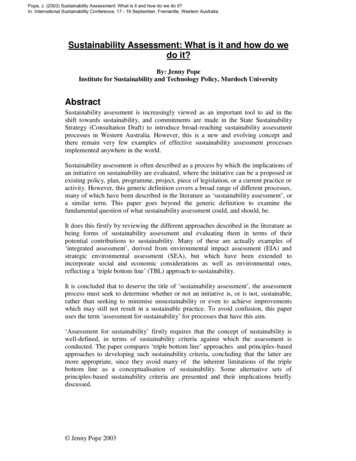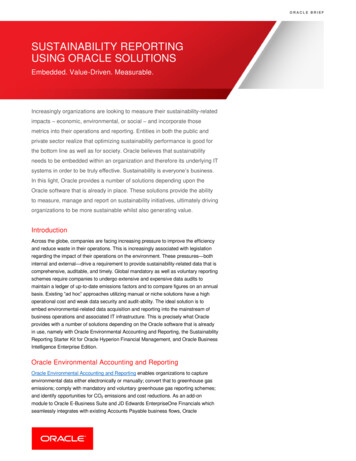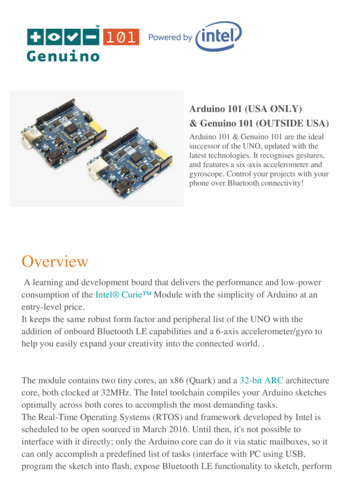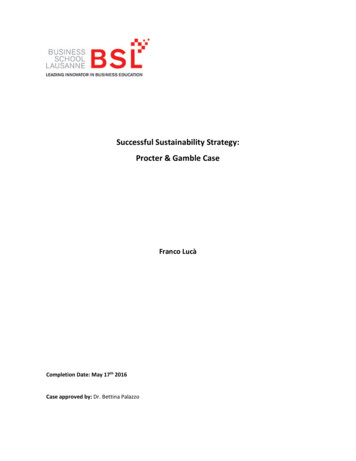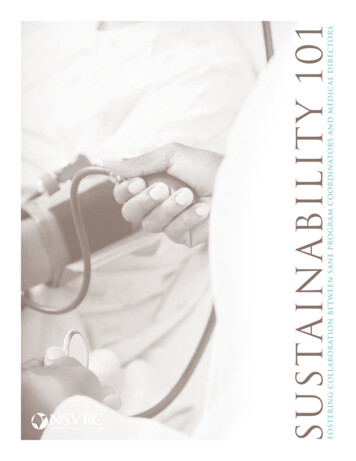
Transcription
Fostering Collaboration Between SANE Program Coordinators and Medical DirectorsSustainability 101
This project was supported by Grant No. 2006-WT-AX-K052 awarded by the Office on Violence Against Women,U.S. Department of Justice. The opinions, findings, conclusions, and recommendations expressed in thispublication are those of the author(s) and do not necessarily reflect the views of the Department of Justice,Office on Violence Against Women.The content of this publication may be reprinted with the following acknowledgement:This material was reprinted, with permission, from the National Sexual Violence Resource Center’s publicationentitled Sustainability 101: Fostering Collaboration between SANE Program Coordinators and Medical Directors.This guide is also available by visiting http://www.nsvrc.org. National Sexual Violence Resource Center 2009. All rights reserved.
Sustainability 101Fostering Collaboration Between SANE ProgramCoordinators and Medical DirectorsJamie Ferrell , Dr. Sally Henin Awad, Jenifer MarkowitzCollaboration occurs when multidisciplinaryproviders commit to share resources andcoordinate or respond to sexual violence as a team.Collaboration brings previously separated entitiesinto a new structure, with a new identity definedby a common mission. (National Sexual Violence Resource Center, 2009)The relationship between a medical directorand a Sexual Assault Nurse Examiner (SANE)program coordinator is like any relationship.There may be times of camaraderie andtimes of discord; how those highs and lowsare weathered can increase the strength ofthe bond or cause it to crumble.Striking a congenial and effective balancebetween forensic nursing practitioners andmedical directors is possible with thoughtfulcultivation. Patients are the beneficiaries ofSANE programs, and their care is enhancedby a productive relationship with medicaldirectors. We talk about collaboration whenreferring to Sexual Assault Response Teams(SARTs), community partners and otheragencies, but how much collaborationoccurs internally between SANEs andphysician colleagues?Many SANE programs begin with the visionof one registered nurse impassioned to makea difference for those who have suffered thetrauma of sexual assault. A physician is thenassigned the task of ‘signing protocols’, oftenby default as a part of his or her job. How oftendo we search for a physician to fill the role ofmedical director who has a complimentaryvision and passion for the job? A medicaldirector that does not share this vision mayhelp accomplish initial program implementation,but will do little to assist with the credibilityand sustainability of a SANE Program.If you are looking for a medical directorfor your program, or are unsure whetherthe medical director you have is the right fit,this bulletin will provide some guidance andstructure to identifying a compatiblephysician to add to the team.Fostering Collaboration Between SANE Program Coordinators and Medical Directors 1
Evaluating Current or PotentialMedical DirectorsSelecting and evaluating a medical directorcan be intimidating. Keeping an open mind isimportant: quality medical directors don’t fit aspecific gender, age or experience profile.emergency medicine physicians consider otherspecialties such as public health officers, familypractice physicians, women’s health practitionersor medical examiners.It is crucial to find aChoose wisely and know where compromise maybe possible. Ask yourself the following questions:medial director who Do you value each other’s contributions?can act as a champion Do you know each other’s limitations?for the program Do you know each other’s scope of practice?It is more important that you have a commonvision/mission, shared values, and mutual respect.It is crucial to find a medical director who can actas a champion for the program. In addition toOpen and frequent communication betweenthe SANE program coordinator and the medicaldirector is the key to a positive workingrelationship and healthy conflict resolution.Choosing a physician who will “rubber stamp” allof your ideas is not the goal; some disagreementis both natural and positive, as long as it occurswithin an environment of mutual respect.Additionally, consider: I s there a sense of responsibility to thepatient, staff, and community? Is the physician a skilled relationship builder? I s the physician open to receiving educationand feedback from nursing colleagues? Is the physician a capable clinical educator? D oes the physician possess the flexibilityexpected of other members of the team? I s the physician respected in the eyes of themedical community and agency administration?2 Sustainability 101
Range of Medical DirectorResponsibilitiesMedical director responsibilities vary fromprogram to program. It is valuable to jointlydetermine what the SANE team’s needs are.They may include: Signing protocols Medication administration Testing orders Standing orders HIV prophylaxis Participation in patient care issues P articipation in a quality assurance/qualityimprovement process Clinical education P articipation in some administrative aspectsof the program P articipation in strategic planning andbenchmarking process A ssistance with clinical expansion andimplementation of new programsFostering Collaboration Between SANE Program Coordinators and Medical Directors 3
Shared VisionRolesAcross the United States there is great diversityof opinion on the purpose of SANE programs.While the SANE program can benefit thecommunity and other stakeholders in multipleways, the SANE coordinator and medicaldirector have to agree on its primary purpose.Medical directors should not serve as refereesAs healthcare providers, the primary purposeof SANE practice is to deliver targeted, qualitypatient care rather than aiding law enforcementin their investigation or improving prosecutionrates. By focusing on this healthcare role, theprocess of investigation and prosecution willalso benefit, according to recent research(Campbell, Bybee, Ford, & Patterson, 2009).The medical director should stand behind thisphilosophy and provide an additional voiceof support for a patient-centered approachwhen questions arise from outside disciplinesregarding SANE practice.patient transfer delays. The medical director canOnce a common vision is agreed upon, otherimportant issues to discuss with the medicaldirector include:volunteer one. The job description of a medicalstaff reimbursement, and nursing practiceissues. However, the medical director shouldbe involved in resolving concerns within thephysician community, such as referral issues andThe job description ofa medical director shouldbe structured and detailedhelp deal with issues that may arise with otherphysicians and allied professionals relating tothe SANE program.As with other positions within the SANEprogram, the medical director needs to havea job description, even if the position is adirector should be structured and detailed sothat there is clear guidance about roles and C ontroversies about SANE/ForensicNursing practiceresponsibilities. See Figure 1 for an example. Practice strengths and limitationsdirector in program administration issues such as A nticipated time commitments for the SANEcoordinator and medical directorhiring, training, orientation, clinical expectations, Salary structure (if any) Medical director liability4for team issues such as addressing scheduling, Sustainability 101Some programs may elect to include the medicaland ongoing competency evaluation. These canbe included in the job description as appropriate.
Figure 1:Title: Medical DirectorReports to: Administrative Director of Emergency and Trauma ServicesBasic Function: Provide consultative services to the SANE Program clinicians, including participationin quality assurance process, pharmacy issues and other medical issues as they arise.Minimum Qualifications: Physician licensed to practice in the state of . Physician in active clinical practice within (name of agency/organization). Named by (agency/organization) as covered physician for patient care under existing policies/procedures.Special Qualifications: Interest in providing quality assurance of SANE Program patient care through chart reviewand feedback. Participation in developing protocols for patient care, medication and referral patterns (suchas the emergency department) upon request of the SANE Program. Interest in clinical teaching of SANE program team. Comfortable with lecturing and other styles of public speaking. Able to work collaboratively with the SANE program coordinator and clinicians. Able to work independently. Able to commit hours a month to the SANE program, including monthly staff meetings.Description of work: Monthly chart review with QA of SANE program cases. Attend monthly staff meeting when able. Lecture to various health care groups as requested by the SANE program. Facilitate communications with Emergency Department staff, Emergency Medicine faculty foreducational programs, and other clinical departments when requested by the SANE program.Fostering Collaboration Between SANE Program Coordinators and Medical Directors 5
Quality AssuranceIdeally, a quality assurance process needs to beOne item discussed in the role of the medicaljointly developed between the SANE programdirector is attendance at regular staff meetings.coordinator and the medical director. It may startRegularly scheduled meetings can provide:off as a form-driven review (e.g. ensuring thatevery line of the chart is completed). It shouldevolve into looking at patient history, evaluating Continuing education Joint discussions on plans of careand images (if available), reviewing genital Support and encouragement to thwartpractice stagnation and burnoutassessment diagrams and images (if available), Quality assurance/peer reviewassessment, reviewing physical injury diagramsand evaluating patient care and discharge plans.The medical director should attend these meetingsIf it is decided that part of the medical director’sand be an active participant in program discussionsresponsibilities is Quality Assurance (QA) review,(and decisions where appropriate). Having a setthen a collaborative process for integrating theagenda and meeting objectives will ensure moremedical director’s input should be developed.consistent turnout by the medical director, and inAutonomous SANE practice is strengthened byfact, all members of the SANE team, who will seethe meetings as time well spent.the collaborative QA review.6 Sustainability 101
Fiscal ManagementFinal ThoughtsAnother component of collaboration betweenthe SANE program coordinator and themedical director is fiscal management.This is a critical point for the sustainabilityof any program. Each SANE programcoordinator should develop a business planfor the program and enhance her or hisadministrative skills while balancing patientcare services. SANE programs are, after all,small businesses and require an organizationto sustain and grow. The medical directormay be able to provide mentoring related totasks such as budgeting or proposal writing(or make suggestions for mentors within theagency or organization).Policies and procedures often clarify the roles ofeach party but there is much that is unwritten inthe relationship between the SANE coordinatorand medical director. A healthy collaboration doesnot happen overnight, but working to improvethe relationship between the SANE programcoordinator and the medical director will benefitpatients and help sustain the program.Fostering Collaboration Between SANE Program Coordinators and Medical Directors 7
REFERENCESCampbell, R., Bybee, D., Ford, J. K., & Patterson, D. (2009). Systems change analysis of SANEprograms: Identifying the mediating mechanisms of criminal justice system impact (NCJDocument No. 226497). Retrieved from dfNational Sexual Violence Resource Center. (2009). National SART toolkit: Resources for sexualassault response teams. Enola, PA: Author.8 Sustainability 101
The Sustainability SeriesThe Sustainability Series is a component of the Sexual Assault Nurse Examiner (SANE) Sustainability TechnicalAssistance Project, which aims to address sustainability issues holistically by working with program coordinatorsto creatively examine the challenges that individuals and communities face in maintaining healthy, successful, andappropriate medical-legal services for victims of sexual violence. Additional information can be found by visitinghttp://www.nsvrc.org.National Sexual Violence Resource CenterThe National Sexual Violence Resource Center (NSVRC), founded by the Pennsylvania Coalition Against Rape,opened in July 2000 as the nation’s principle information and resource center regarding all aspects of sexualviolence. The NSVRC provides national leadership in the anti-sexual violence movement by generating andfacilitating the development and flow of information on sexual violence intervention and prevention strategies.About the AuthorsJamie Ferrell, BSN,RN,CA/CP-SANE,CMI-III,SANE-A,CFN,SANE-P is currently the clinical manager for theMemorial Hermann Healthcare System - Forensic Nursing Services. This is the largest not-for-profit healthcaresystem in Texas and serves the greater Houston community. Ms. Ferrell also provides education nationally andinternationally on a variety of issues surrounding victims of crime and nursing practice.Sally Henin Awad, MD FACEP is the Medical Director of the Memorial Hermann Hospital System Forensic NursingProgram in Houston, TX. In addition, she is an Emergency Medicine Physician and serves as co-chair of theAmerican College of Emergency Physicians Forensic Medicine Section - Adult/Adolescent Sexual Assault. Shelectures nationally on emergency medicine and forensic medicine topicsJenifer Markowitz, ND, RN, WHNP-BC, SANE-A, is currently the project manager for the National SANESustainability Technical Assistance project with the NSVRC. In addition, Ms. Markowitz teaches and consultsnationally on a wide range of topics related to the practice of forensic nursing.www.nsvrc.orgNSVRC123 North Enola Drive, Enola, PA 17025Toll free: 877-739-3895resources@nsvrc.org
A publication of the National Sexual Violence Resource CenterFounded by the Pennsylvania Coalition Against Rape
Fostering Collaboration Between SANE Program Coordinators and Medical Directors. This project was supported by Grant No. 2006-WT-AX-K052 awarded by the Office on Violence Against Women, . (Campbell, Bybee, Ford, & Patterson, 2009). The medical director should stand behind this philosophy and provide an additional voice of support for a .
